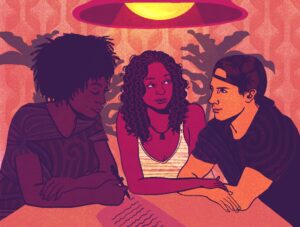Intersectionality & Reproductive Justice
Resources for Learning
People of all races, genders, incomes, sexual orientations, abilities, and immigration statuses need abortions. That’s why it’s essential to learn about intersectionality and Reproductive Justice. Without these frameworks, it’s impossible to achieve true abortion justice.
Use these resources to learn more and start working to make abortion accessible for ALL.
Understanding Intersectionality
Intersectionality is a lens through which you can see where power comes and collides, where it interlocks and intersects.”
Dr. Kimberlé Crenshaw

Scholar and civil rights activist Dr. Kimberlé Crenshaw created the term “intersectionality.” This term describes how multiple kinds of discrimination overlap and impact people in marginalized groups.
For many, the effects of intersecting oppressions are felt every day. We know that racism, classism, sexism, and other types of discrimination affect abortion policies. Folks impacted by multiple types of discrimination experience barriers to abortion access that others do not.
Understanding intersectionality is a big part of achieving Reproductive Justice.
Understanding Reproductive Justice
The term Reproductive Justice was created in 1994 by a group of Black women who named their collective the Women of African Descent for Reproductive Justice. By 1997, SisterSong was formed and Reproductive Justice became a national, multi-ethnic movement.
“An intersectional theoretical analysis defined by the human rights framework applicable to everyone, and based on concepts of intersectionality and the practice of self-help. It is also a base-building strategy for our movement that requires multi-issue, cross-sector collaborations. ”
SisterSong

The Reproductive Justice framework goes beyond other gender equality, abortion rights, or pro-choice frameworks.
Unlike these other approaches, Reproductive Justice always considers the many ways institutions, cultural norms, and systems of oppression exert control over people and their reproductive choices.
Learn More About Intersectionality And Reproductive Justice
Use these resources to understand intersectionality and Reproductive Justice. Learn, reflect, and grow.
- SisterSong: What is Reproductive Justice?
- Loretta Ross: Reproductive Justice 101
- Brené Brown: TED Talk on Vulnerability
- Brené Brown: On Empathy (animated)
- Alexis Pauline Gumbs: Revolutionary Mothering
- Steven Universe: Here Comes a Thought (animated and child-friendly)
- Morgan Gale: What is Reproductive Justice?
- Kimberle Crenshaw, TED Talk: The Urgency of Intersectionality
- Dorothy Roberts, TED Talk: The Problem with Race-based Medicine
- ICAH Participatory Youth Action: Research Findings on Given & Chosen Families (video)
- Audre Lorde: There is no Hierarchy of Oppressions
- ICAH Participatory Youth Action: Research on Given & Chosen Families (PDF)
- bell hooks: Feminism is for Everybody
- Political Research Associates report: Defending Reproductive Justice
- Angela Davis, free ‘zine: Lectures on Liberation
- Abortion fund leaders: How to Talk With Your Family and Friends About Abortion
- Kimberle Crenshaw: Mapping the Margins: Intersectionality, Identity Politics, and Violence Against Women of Color
- Gloria Anzaldua: Borderlands/La Frontera: The New Mestiza
After Reviewing, Consider These Questions:
- Name one step to ensure the abortion justice movement doesn’t overlook people in marginalized groups.
- What are the biggest differences between reproductive rights, reproductive health, and Reproductive Justice?
- Identify examples of race-based medicine that still exist today. How do the examples create disparities? And what do these disparities lead to?
- Can religion and science exist in harmony? Why or why not?
- What practical role do abortion funds play in achieving Reproductive Justice?